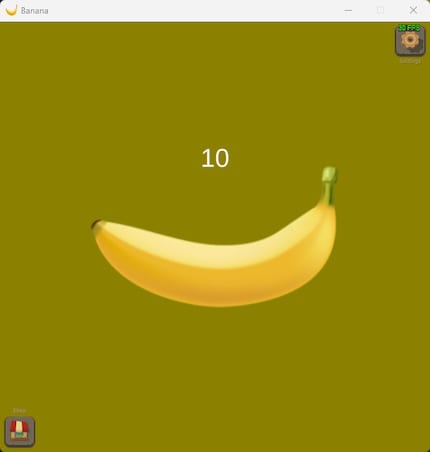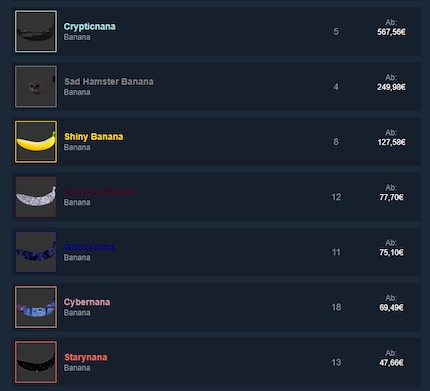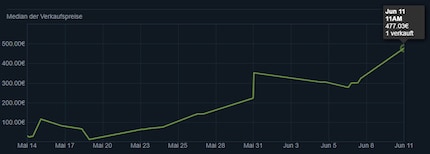
Background information
Valve gets in touch with Valais-based game developer upon his successful demo
by Philipp Rüegg

The mini-game Banana’s been attracting more and more players every week. The gameplay? Clicking a banana. Why would so many people do this?
It doesn’t always have to be sophisticated gameplay with large game worlds or complex skill trees. In fact, sometimes a banana is all it takes to capture thousands of players. The gameplay of Banana couldn’t be simpler: click a banana and now and then you’ll get a useless item for your Steam inventory in return. That’s it. And yet, the game has hundreds of thousands of players – all hoping for rare drops that can be sold at a high price.

The mysterious game Banana, which was released in April, didn’t escape the editorial team’s attention. In fact, we’ve been following the trend for weeks, but always assumed the phenomenon would soon subside. On Thursday 13 June, however, the game cracked the incredible mark of 400,000 concurrent players. Right, that’s it. I need to know what the secret of Banana is.
There isn’t much to say about what the free game’s about. When you launch it, a small window with a banana opens. That’s all. Click the banana once in three hours and you might win a banana skin for your Steam inventory. Yes, you read it right, the item doesn’t even change the skin of the banana in the actual game. It’s just a virtual item for the Steam store. Click the banana once in 18 hours and you have the chance to win a rare Banana skin.
However, the game has to run in the background – which explains the high number of concurrent players. Banana needs hardly any resources – only a processor with a clock frequency of one gigahertz, 128 megabytes of RAM, 30 megabytes of memory and any graphics card.
So why are so many people playing this sensationally simple game? For one reason only: to be in for a chance to earn money. Real money. So far, more than 70 banana skins have seen the light of day in Steam inventories. Items from the inventory can be sold on the Steam marketplace.

When I checked on 14 June, the most expensive skin on offer was the Crypticnana. Five of them were for sale for a starting price of around 567 euros or 541 francs. Nobody’d be interested in buying a virtual banana skin, right? Oh, quite the opposite. This diagram shows how often and for what price this skin has already been sold. On 11 June, it was bought for around 477 euros or 455 francs. Trend? Upwards.

If the seller earned this much by clicking on the banana once, that one click was definitely worth it. According to the description of the Crypticnana, this skin’s limited to 25 drops. Most of the other rare drops are also only available in small quantities. And as always, limited offer increases demand even if the item serves no purpose at all.
But why the heck would anyone buy such a skin for so much money? It’s a classic speculative item. The Steam community knows the skin’s very rare. Anyone who buys it is speculating that it might sell for more later. And the price trend proves this assumption right.
What about the developers? Well, they’re relying on a business model that actually makes them money. The skins are offered and sold thousands of times at a minimum price of 0.03 euros. The developers get ten percent; Steam gets five percent. According to the Steam charts, the Musicnana skin, for instance, was sold more than 100,000 times within an hour on 14 June. At 0.003 euros per sale, that equals 300 euros or 286 francs. That’s proceeds from just one skin within one hour.
However, one of the developers has put this calculation into perspective. In response to a negative review, he said that most users aren’t from Europe, but from countries where the minimum price and therefore the retail price are significantly lower. Nevertheless, it’s a lucrative business compared to the minimalist effort required to play the game.
Feels just as comfortable in front of a gaming PC as she does in a hammock in the garden. Likes the Roman Empire, container ships and science fiction books. Focuses mostly on unearthing news stories about IT and smart products.
Interesting facts about products, behind-the-scenes looks at manufacturers and deep-dives on interesting people.
Show all
Background information
by Philipp Rüegg

Background information
by Oliver Herren

Background information
by Debora Pape